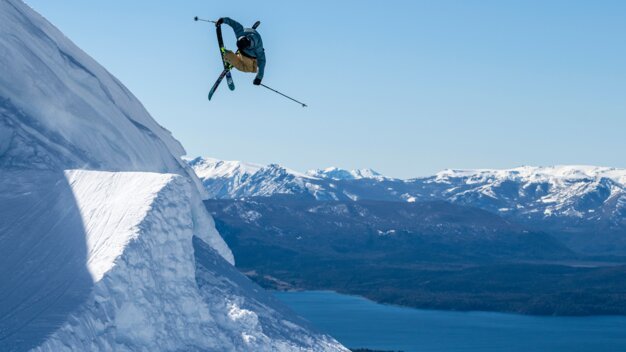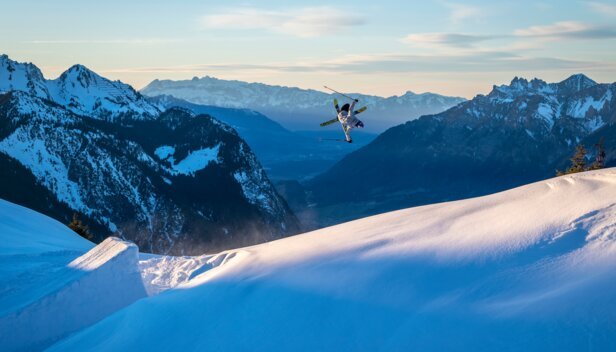
Are you planning to hit the terrain park soon, but you don’t have the right bindings for it yet? Don’t worry, we’ve got you covered! Our experts at INTERSPORT Rent sat down to give you the ins and outs of freestyle bindings. Read up on our tips, get the bindings that suit you best, and have fun jumping and jibbing on your next trip to the ski resort!
What to keep in mind when getting freestyle bindings
From the right material to the optimal DIN setting: There are a few things you should consider before you run out to grab a brand-new pair of freestyle bindings. We’ll tell you what to look out for!
Material
For the snow park, you need a set of bindings that can take a bit of a beating. What do we mean by that? If you want to safely slide rails and land even the trickiest jumps, you need bindings that won’t crack and crumble upon impact. Most freestyle bindings are made from varying amounts of both plastic and metal.
Simple rule of thumb: The more plastic, the lighter and more affordable they are – but they tend to lack stability. Metal bindings are generally heavier and sturdier, which makes them more impact resistant. So even though mostly metal bindings are slightly more expensive, they’re the safer and more durable choice. They’ll last you for years, which makes them well worth the investment.
Interesting fact: Some manufacturers also offer bindings with magnesium parts. Magnesium used to be one of the main metals used in aerospace construction because of its low weight and high strength. No wonder these bindings are the perfect choice to get you airborne!
DIN setting
All bindings come with adjustable release force settings, also known as DIN. The DIN number tells you how easily the bindings will release under an applied force. But what number should you be aiming for?
Well, the Goldilocks principle applies: Your bindings need to be sensitive enough to release in the event of a fall, otherwise you risk injuring yourself. At the same time, they need to “lock you in” enough that you can hit kickers and stand your landings without losing a ski.
Three factors go into figuring out your DIN setting:
- Skill level: probably the most important of the three. If you’re a newcomer to the sport, you don’t want your DIN setting to be too high, so the bindings can release if you take a tumble. If you’re a more seasoned skier, you can go for a higher DIN setting so the bindings don’t release prematurely as you’re practising your tricks.
- Skier height, weight, and foot size: Lighter and shorter skiers need a lower DIN setting. Tall and heavy skiers need a higher one.
- Skiing style: If you’re an easy-going rider, you can get away with a lower DIN setting. If your skiing style is on the aggressive side, shoot for a higher number.
Our tip:
When shopping for bindings, you’ll see that most bindings have a number associated with their name, and this tends to be the maximum DIN setting of the binding. This helps you decide which bindings you need, but keep in mind: You don’t want to be too close to the maximum setting.
We don’t recommend you adjust the DIN setting on your bindings yourself – leave that to the professionals of INTERSPORT Rent! However, you should definitely let them know what you’re planning to do with your skis. If you’re mostly going to the park to slide rails and obstacles, be sure to tell them! This way they can optimally adjust the bindings to your needs and preferences.
Mounting position
Most all-mountain and backcountry skis have the bindings mounted further towards the tail of the ski. This can make practising your tricks at the park a lot harder, as you always land with your weight on the bindings. On park skis, you want the bindings to be positioned in the middle of the ski. This way you’ll have more control over them.
Other considerations
If you’re planning to spend a little more cash on your bindings, you should look for some that come with replaceable brakes. The advantage: If you get stuck on something – especially if you land switch – and you damage the brakes, you can simply exchange them. So you won’t have to replace the entire binding or even your skis.
Another factor to consider is that many bindings are mounted onto plates to make them sit a little bit higher. While that’s great for carving because it allows you to achieve a better angle, it’s not so great for freestyle skiing. You don’t want to be making carving turns as you approach a jump. Instead, it’s better to have a lower centre of gravity which gives you better balance and more control over your skis. So your bindings should be positioned relatively low on your skis – with a low or even no plate.
Can you go freeride skiing with park bindings?
The answer is … yes and no. In theory, you could – but it’s usually not very practical or safe. Park bindings don’t have a hike mode, so they’re not suitable for climbing.
A word of caution: If you’re out in off-piste terrain, you should ALWAYS have bindings with hike function. Imagine one of your buddies has an accident or gets caught in an avalanche – you’ll want to be able to get back up the mountain to help them as fast as you can. And that’s simply not possible if you’re trying to walk up the mountain in powder snow and you only have ski boots on …
However, if all you want to do is hit the pow just off the slopes and you take the lift up the mountain, then park bindings will do just fine.
Are you also looking for a new pair or freestyle skis?
Then take the time to read through our article on the perfect size freestyle skis!
INTERSPORT Rent tip
If you’re still unsure about how to find the bindings that suit you best, why not stop by at INTERSPORT Rent? The RENTertainers, our winter sports experts at the ski resorts, are happy to advise you. They’ll gear you up for your next visit to the terrain park!






